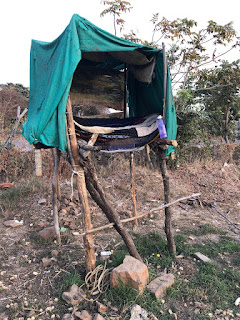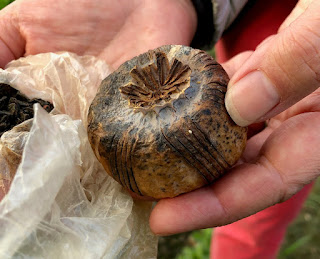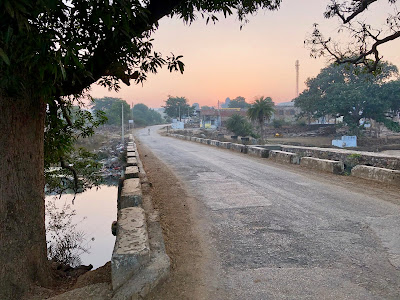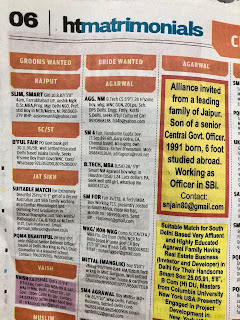8. Outings from Bijaipur - Opium tea, Udaipur, Fabric printing, Dam sunset.
Opium tea-drinking ceremony
Our evening began with a visit to the fields where the poppies are grown. They are grown under a licence from the government which dictates how much land can be used, how many kgs can be grown and the price that the government will pay for it .... Farmers here are licensed to grow 0.1 ha (0.25 acre) of poppies and to maintain their licence have to produce 56kg of raw unadulterated paste for which they are currently paid 3500/-rs per kg (approximately £44). However, if they manage to grow more than the prescribed amount it will fetch 80 - 90,000/- rs (£1,000 - 1,125).
There was a look out den beside the crop so that someone can keep an eye out for animals that might stray there.
The poppy flowers are white and the seed heads formed were larger than I had expected. The skin of the ripening pod is scored with a nushtar or nishtar (from Persian word meaning lancet) which carries 3 or 4 blades 3mm apart, scored upward at a carefully chosen time so rain, wind and dew cannot spoil the exudation of the white milky latex, usually in the afternoons. The incisions are made 3 or 4 times at intervals of two or three days and each time these poppy tears are collected and dried to a sticky brown resin.
From the fields we travelled on to a local Kelijhar village where the locals are made up of the gurjar (milkman) cast. Some historians claim that they come from central Asia (today's Armenia and Georgia). Due to their historic influence areas of northern India and Pakistan have been named after them, including the Gujarat District.
A "tea" was made by grinding the opium resin, mixing it with a little water until it dissolved and then straining it 3 or 4 times through a material strainer, hanging on a metal "Trident of Shiva". This was traditionally a religious ceremony that was carried out for guests.
The tea had a really bitter taste! The children enjoyed us as much as we did them!
Other older men in the village joined us
Enjoying their bidis, which they hold between the fingers and then sucked through the hole made by a thumb and index finger in a fist so that they can be easily shared.
Udaipur
Although we flew into Udaipur from Delhi when we arrived in Rajasthan, we went straight to the hotel, nearly 3 hours away. In order to explore Udaipur, the "City of Lakes", we left very early in the morning so that we could spend the day there. Udaipur was founded in 558 by Maharana Udai Singh II when he shifted his capital from the city of Chittorgarh. The city was built on the edge of Lake Pichola and there are also 6 more lakes nearby. Fantastical palaces and temples are connected by countless narrow, crooked timeless streets.
Udaipur is also known as the Venice of India. It is easy to see why!
We shared a delicious lunch looking out over the lake.
In the afternoon we enjoyed a boat ride passing the palaces and seeing them from their best side.
Then the sun started to set. Every time I thought it was at its very best, it just got better!!
Fabric Printing, Tarapur

I am very interested as to how the local fabrics are printed. I asked KP and he kindly offered to take us to a workshop where they print in a traditional way. He took just 3 of us to Tarapur, a small village on the Rajasthan border.

I am very interested as to how the local fabrics are printed. I asked KP and he kindly offered to take us to a workshop where they print in a traditional way. He took just 3 of us to Tarapur, a small village on the Rajasthan border.
I have to confess that it was not what I expected at all! They use a very old method of printing the fabric with a sort of clay mixture which acts as a barrier to the dye - a bit like the batik process. The sari length cloths are laid out on tables and the patterns applied.
The wooden stamps are bought in and are an investment - costing up to £30 each. They are much deeper than the ones that I had seen for sale. They were everywhere on all the shelves!


The clay mixture was made from a mix that was also bought in and piled in the corner of the workroom.



The clay mixture was made from a mix that was also bought in and piled in the corner of the workroom.

This is then mixed with water to form a sludge which is then slowly pressed through a piece of material to ensure that there are no lumps or impurities. This man sits all day doing this! It is then put into a tray from which the stamps can be dipped.










Once the pattern has been printed it is then sprinkled with sawdust to absorb any excess that the fabrics are taken onto the roof to dry.


The owner also showed us how he printed in a more traditional way with natural dye. His son and cousins were keen to practice their English and discover my views on the English cricket team - not a strong area of knowledge for me!


As we left the workshop we met some children from the school.


Sunset by the dam.
One evening we went for a lovely evening to watch the sunset on a nearby dam.






































Comments
Post a Comment